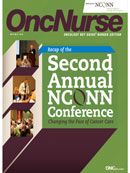Net Guides: Bone Metastases
Useful Online Resources and Clinical Trials for Bone Metastases
//THE ONLINE Nurse
Bonetumor.org
Bonetumor.org is a nonprofit organization that provides information on bone tumors to healthcare professionals and their patients. The Website features a large number of articles contributed from researchers and physicians around the globe, covering more than 100 different types of bone tumors and bone tumor topics. In the “Tumor Information” section, visitors can find tumor information by type or category, browse a bone tumor image library, read about delay and error in tumor diagnosis, and access a spotlight section on tumors of the foot and ankle. The “Learning Resources” section is largely for healthcare professionals and includes actual clinical cases of bone tumors, an article on the evaluation of pathologic fracture risk due to a tumor, first steps to take in the management of a bone tumor, an overview of limb salvage surgery, and a collection of bone tumor learning modules. Bonetumor.org is also available in Spanish.
//THE EDUCATED PATIENT®
Managing Pain Related to Cancer and Bone
This PDF booklet, which was published by the Bone and Cancer Foundation (BCF), educates patients on various topics regarding pain management related to cancer in the bones. The topics are presented in the form of questions and cover subjects such as how pain is measured, how bone metastases pain feels, and how it is treated. The booklet also covers the types of medication used to treat bone metastases and offers a table with commonly used over-the-counter and prescription medications. Later sections cover alternative treatments, when surgery is required, and which medical specialists help manage pain. The BCF, a program of the Paget Foundation for Paget’s Disease of Bone and Related Disorders, offers a number of other patient education booklets on bone metastases, which can be downloaded from its home Website at boneandcancerfoundation.org.
Questions and Answers About Breast Cancer, Bone Metastases, & Treatment-Related Bone Loss
This PDF, which is provided by the Bone & Cancer Foundation, provides Q&As on the relationship between breast cancer and bone health, decreasing the chance of breast cancer spreading to the bone, finding out if breast cancer has spread to the bone, problems caused by breast cancer in bone, and treating breast cancer that has spread to the bone. Some of the specific questions include, “What parts of the skeleton are most likely to be affected by breast cancer?” and “What problems are caused by the spread of breast cancer to the bone?” The PDF includes a glossary of terms related to cancer-related bone issues.
www.boneandcancerfoundation.org
//eABSTRACT
Preventing bone complications in advanced prostate cancer
Journal: Current Oncology
Authors: Luz MA, Aprikian AG
Although the diagnosis and treatment of prostate cancer continues to improve, most patients with advanced cancer will still develop disease metastatic to bone, leading to severe pain, fracture, spinal cord compression, marrow failure, or hypercalcemia. Androgen deprivation therapy (ADT), the standard treatment for advanced prostate cancer, increases the risk of bone disease. In this review, the authors discuss the current strategies and advances for preventing skeletal complications associated with advanced prostate cancer and with the use of ADT. The authors conducted a computer-assisted search of the PubMed database using the keywords “prostate cancer,” “bone metastases,” “androgen deprivation therapy,” “skeletal complications,” and “bisphosphonates,” identifying relevant articles. Citations from other papers were also selected for the review.
The review begins by discussing the pathophysiology of bone metastases, bone complications induced by ADT in patients with advanced prostate cancer, and the clinical manifestations and diagnosis of skeletal metastases. It then focuses on targeting bone metastases, discussing bisphosphonates, denosumab, and bone-seeking radiopharmaceuticals. The following sections of the article discuss the roles of radiation and chemotherapy in this setting, and a look at new drug development. The final section covers the prevention of ADT-related bone complications. The authors concluded the review by stating that although no therapeutic modality has demonstrated significant improvement in overall survival, a number of new treatments have shown palliative improvements and the ability to prevent major bone complications. They emphasize that physicians must evaluate the risk of bone metastases in each patient and follow disease progression carefully in order to detect and treat metastatic disease to the bone early in patients with prostate cancer.
//CLINICAL TRIAL
Single-fraction compared with multiple-fraction therapy in treating patients with previously irradiated painful bone metastases
Study Type: Interventional
Age/Sex Requirements: 18 years (None)
Sponsor: NCIC Clinical Trials Group
ClinicalTrials.gov Identifier: NCT00080912
Purpose: This randomized, multicenter phase III trial is testing to determine whether single-fraction radiation therapy is as effective as multiple-fraction radiation therapy in treating patients with previously irradiated painful bone metastases. The primary measure of the study will be the pain relief experienced by patients undergoing single-fraction versus multiple-fraction re-irradiation at 2 months after treatment. Secondary measures include overall pain relief, time to pain progression, the correlation of initial irradiation response with pain relief after re-
irradiation, changes in functional interference, quality of life, characteristics of nonresponders, the incidence of acute severe radiation-related side effects, and the incidence of in-field pathological fractures and spinal cord compression.

Innovative Program Reduces Nurse Turnover and Fosters Development
Published: September 12th 2024 | Updated: September 12th 2024The US Oncology Network (The Network) has developed one of the most comprehensive programs in the nation to support the professional development and retention of new oncology nurses.



